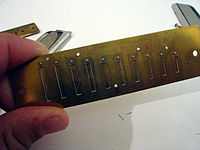Harmonica
A harmonica reed is a flat, elongated spring typically made of brass, stainless steel, or bronze, which is secured at one end over a slot that serves as an airway.When the free end is made to vibrate by the player's air, it alternately blocks and unblocks the airway to produce sound.Those saying no argue that unlike the soundboard of a piano or the top piece of a violin or guitar, a harmonica's comb is neither large enough nor able to vibrate freely enough to substantially augment or change the sound.Few dispute that comb surface smoothness and air tightness when mated with the reed plates can greatly affect tone and playability.This can cause the comb to expand slightly, making the instrument uncomfortable to play, and to then contract, potentially compromising air tightness.Some players used to soak wooden-combed harmonicas (diatonics, without wind-savers) in water to cause a slight expansion, which they intended to make the seal between the comb, reed plates, and covers more airtight.In the late 19th and early 20th centuries, harmonicas not uncommonly had special features on the covers, such as bells, which could be rung by pushing a button.Wind-savers are one-way valves made from thin strips of plastic, knit paper, leather, or Teflon glued to the reed plate.One of the early innovators of this approach was Marion "Little Walter" Jacobs, who played the harmonica near a "Bullet" microphone marketed for use by radio taxi dispatchers.Also, tube amplifiers produce a natural growling overdrive when cranked at higher volumes, which adds body, fullness, and "grit" to the sound.Many amplifiers designed for electric guitar are also used by harmonica players, such as the Kalamazoo Model Two, Fender Bassman, and the Danelectro Commando.This device is used by folk musicians, one-man bands, and singer-songwriters such as Bob Dylan, Edoardo Bennato, Tom Harmon, Neil Young, Eddie Vedder, Billy Joel, Bruce Springsteen, and blues singers Jimmy Reed and John Hammond Jr.The chromatic harmonica uses a button-activated sliding bar to redirect air from the hole in the mouthpiece to the selected reed-plate, though one design—the "Machino-Tone"—controlled airflow by means of a lever-operated flap on the rear of the instrument.Also, a "hands-free" modification to the Hohner 270 (12-hole) lets the player shift the tones by moving the mouthpiece up and down with the lips, leaving the hands free to play another instrument.This provides a unique wavering or warbling sound created by the two reeds being slightly out of tune with each other and the difference in their subsequent waveforms interacting with each other (its beat).This gives a quick pitch-alternating technique that is slightly more than vibrato and achieves the same aural effect on sustained notes, albeit by using two different tones instead of varying the amplitude of one.They became relatively well known in Europe after being introduced by the French Jesuit Jean Joseph Marie Amiot (1718–1793), who lived in Qing-era China.In Germany, violin manufacturer Johann Georg Meisel from Klingenthal bought a harmonica with chambers (Kanzellen) at an exhibition in Braunschweig in 1824.In the 21st century, radical new designs have been developed and are still being introduced into the market, such as the Suzuki Overdrive, Hohner XB-40, and the ill-fated Harrison B-Radical.Major companies are now found in Germany (Seydel and Hohner – the dominant manufacturer in the world), South Korea (Miwha, Dabell), Japan (Suzuki, Tombo – the manufacturer of the popular Lee Oskar harmonica, and Yamaha also made harmonicas until the 1970s), China (Huang, Easttop, Johnson, Leo Shi, Swan, AXL), and Brazil (Hering, Bends).It is also during those years that musicians started experimenting with new techniques such as tongue-blocking, hand effects and the most important innovation of all, the second position, or cross-harp.A significant contributor to the expanding popularity of the harmonica was a New York-based radio program called the Hohner Harmony Hour, which taught listeners how to play.The radio program gained wide popularity after the unveiling of the 1925 White House Christmas tree, which was adorned with fifty harmonicas.American Larry Adler was one of the first harmonica players to perform major works written for the instrument by the composers Ralph Vaughan Williams, Malcolm Arnold, Darius Milhaud, and Arthur Benjamin.Furthermore, the primary harmonica manufacturers were based in Germany and Japan, the enemies of the United States and the Allied forces in the war.During this time, Finn Haakon Magnus, a Danish-American factory worker and entrepreneur, developed and perfected the molded plastic harmonica.During the 1950s, chromatic harmonica became popular in Hong Kong, and players such as Larry Adler and John Sebastian Sr. were invited to perform.[11][12][13][14] When President Ronald Reagan suffered a punctured lung in the 1981 attempt on his life, his breathing therapist was Howard McDonald, of the Cambridge Harmonica Orchestra.Orchestra director Pierre Beauregard had hoped that Reagan's therapeutic harmonica experience would help them get a chance to play at the White House, but this never occurred.It is played by touching the rotating cups with wetted fingers, causing them to vibrate and produce a sustained "singing" tone.






Glass harmonicaHarmonica (disambiguation)MelodicaWoodwind instrumentblues harpClassificationaerophoneHornbostel–Sachs classificationFree reed aerophonePlaying rangeRelated instrumentsMelodeonList of harmonicistsChromatic harmonicaRichter-tuned harmonicatremolo harmonicamouth organfree reedwind instrumentAmerican folk musicclassical musiccountry
diatonicRichter-tunedbendingembouchuretitaniumdiatonicsHohnerSuzukiMark Wennertube amplifiersLittle WalteroverdriveShure SM 58effects unitsreverbtremolooctavechorus effectJohn PopperBlues Travelersolid-statevacuum tubeselectric guitarFender BassmanDanelectro Commandoboutique amplifiersJoan BaezBob Dylanone-man bandsEdoardo BennatoTom HarmonNeil YoungEddie VedderBilly JoelBruce SpringsteenJimmy ReedJohn Hammond Jr.intervalperfect fifthpush-buttonseventhaugmenteddiminishedpitch pipeHarmonica techniquesHoward LevyovertonesJean Joseph Marie AmiotQing-eraChristian Friedrich Ludwig BuschmannCharles WheatstoneAeolian harpAnton ReinleinAnton HaecklKlingenthalBraunschweigGraslitzBohemiaCzechoslovakiaTrossingenC. A. Seydel SöhneC.A. Seydelfolk musicLee OskarYamahaBrazilUnion, New JerseyMagnus Harmonica CorporationBeloit, WisconsinAbraham LincolnConfederateAmerican Civil WarWyatt EarpBilly the KidDeFord BaileyHammie NixonWalter HortonSonny TerryHillbillyFrank HutchisonGwen Fosterjug bandsMemphis Jug BandLarry AdlerRalph Vaughan WilliamsMalcolm ArnoldDarius MilhaudArthur BenjaminWorld War IIMagnus harmonicasWar DepartmentRed CrossJohn Sebastian Sr.Asia Pacific Harmonica Festivaldiaphragmlung volumePulmonaryspirometerPresident Ronald Reagan1981 attempt on his lifeCambridge Harmonica OrchestraWhite Houseconcertinaaccordions
